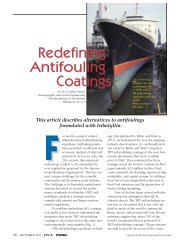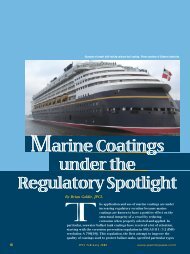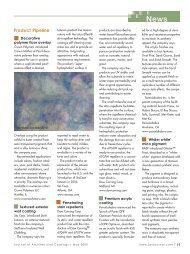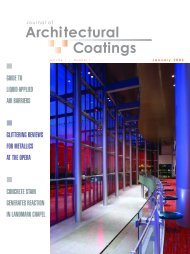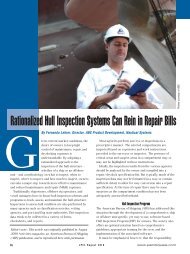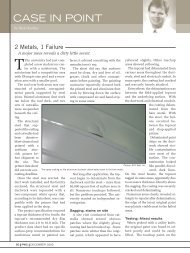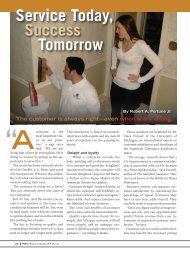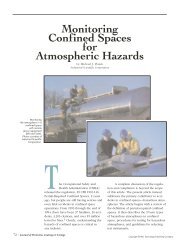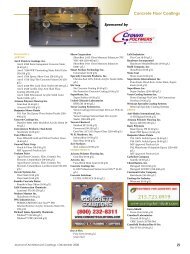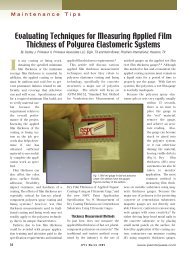PARODI - PaintSquare
PARODI - PaintSquare
PARODI - PaintSquare
You also want an ePaper? Increase the reach of your titles
YUMPU automatically turns print PDFs into web optimized ePapers that Google loves.
<strong>PARODI</strong>by Jim ParodiON PAPERHANGINGHanging the AmpersandsWant the secret to high-end installations? Think potatoes.Ihave been getting one or twocalls a week from consumerswhose high-end wallpaper jobwas botched in some way. A recenttrip to estimate a redo inManhattan revealed abotched job of breathtakingproportions. If the perpetratorshad known only a fewsimple techniques and tips,they could have avoided thismess.All of us want to avoidmessing up the high end.Sales statistics show two“healthy” areas of wallpaperthese days: commercial andthe higher end. If you feel outof your depth when asked tohang one of those high-endmaterials, this column is foryou.The perils of pre-mixedStart by closing the lid on yourfive-gallon pre-mixed adhesive andopening a package of powderedstarch adhesive instead.Fifty years ago, that would nothave been a problem; powdered adhesivewas all you could find in thepaint store. Then, in the late 1960s,the advent of thick, paperbackedvinyl and metallic foils launched atrend toward pre-mixed adhesivesthat all but took over the market.Why not use pre-mixed on pulpypaper-papers? And why is it meaninglesspap when a pre-mixed clearclaims to be “non-staining?”Here’s why. All pre-mixed wallcoveringadhesives use modifiedvegetable starch. In the U.S. today,that typically means corn starch,due to its low price. (That maychange, by the way, if ethanol productionfor gasoline starts to put thepinch on supplies.) Starch is modifiedto stabilize its viscosity, so thatit flows predictably in machines forall sorts of food and industrial applications.Modification involvescooking the starch, then employingacids to break down the polymerchains to reduce average molecularweight. (Stick with this; it will beover soon.)When the corn starch is cooked,the starch granules break down to relionsto convince consumers to faintwith horror at any sign of “ringaround the collar” or “underarmstain,” so they sure don't want to seeCole & SonUsing the right adhesive can help prevent staining today’s delicatepapers. Your best bet: powdered wheat or potato paste.it on their wallpaper.Many of the ampersand instructionsspell out the need for hanginga blankstock underlayment to avoidstaining. Even if it isn’t spelled out,it is good to use blankstock with anypulp. But don't get complacent, becauseblankstock is not enough.And why not? It has to do with thepaste. You actually get three opportunitiesto ruin these types of jobswith paste staining. You can do sowith surface staining; with wetThis & thatWhat is the “high end” I’mtalking about? Paperhangersnationwide are seeing anuptick in rollage from companieswhose names havethat funny little symbol &—the ampersand. There's Cole & Son,Brunschwig & Fils, Cowtan & Tout,Osborne & Little, Graham & Brown,Farrow & Ball, and Morris & Co., aswell as some non-ampersands likeZoffany and Sanderson.These materials are devoid ofvinyl. Instead, they have a traditionalpulpy paper background,which, like the “quicker pickerupper” of old, stands ready to absorband show any contaminant staining.Madison Avenue has spent bilstainingor “strike through”; or withdry staining, which occurs long afterthe material is installed.The good news is that choosingyour paste carefully can head off thistrifecta of disaster.22 PWC NOVEMBER 2009
<strong>PARODI</strong> from last pagematerials tend to have matte inks,which are easily burnished (madeshiny) by robust wiping. So it’s bestWallcovering Buying GuideThe Advance Equipment Manufacturingcompany offers itsB562-HD Manual, gear drivenpasting machine for heavier materialsup to 62 inches wide.Stainless steel tankwith two removableand three fixed rollers.Paste roller is hard coat anodizedfor ultimate protection.Rolling Stand, adjustable inheight, has 4 in. industrial locking casters. Legs fold under machinefor easy transport. Has a drain plug for quickclean-up.Also, has measuring counter complete with stainless steelbracket and 2 gear wheels. Shown here is model number 50621the 62 in. Paste Machine complete with rolling stand and measuringcounter.4615 W. Chicago Avenue •Chicago IL 60651800-621-4516 •www.advance-equipment.comCircle No. 50 on Reader Service Cardto keep wiping to a minimum.A side note: Matte-inked surfacesshould not come into contact withplastic or metal smoothers. A shortbristledsweep is recommended,but Iprefer a plasticsmoother to be certainthere are no bubbles.So here's afoolproof tip if youwant to use asmoother: Cut a 2' x2' piece from a scraproll of pulp. Hold thescrap with the patternside against thesheet you're installing.Use thesmoother on the backof the scrap, repositioningit each timeyou smooth. Thisprevents both thedragging that causesburnishing and therisk of the smootherpressing adhesiveinto the porous surfaceif it picks up anystray paste.Wet Staining orStrikethrough. When you paste thesematerials, it should be done by handwith a brush or roller. (A machinemay be used for a large job, but bedarn sure that the material is free of“cornrows” when dry before proceedingon the project.) When pulpsget wet, they darken or “blush.” Thisis normal. If you have followed thesteps outlined above and used apowdered adhesive with sparklingclean water, those blush marks willlighten when the paper dries, andthe paper will not show any watermarks.Also, if you hung blankstock as youshould have, it will help absorb thewater and counteract any wet staining.An added precaution is to “paste size”the blankstock and let it dry completelybefore hanging the patternpaper. This makes for an even thirstierwall, so that the paste moisture startsto travel away from your sheet almostimmediately upon contact.Dry Staining. Several years ago,the NGPP’s Chris Murphy in Atlantatipped me off to some supposedly“non-staining” pre-mixed that wascausing dry staining. He called itparchmentization, where a uniformlycream-colored ground paperCircle No. 52 on Reader Service CardCircle No. 51 on Reader Service CardWhere to Buy AdhesiveFor potato starch, call Roos International at 800-888-2776 or visit www.roosintl.com and click on “EcofixAdhesive.” This is Swedish potato starch. Why doesn'tthe U.S. produce potato starch wallcovering adhesive?It’s because U.S. producers make five times the profitwith potato starch for food products, as opposed to potatostarch for industrial uses. European governmentsheavily subsidize potato starch, so we get some advantageon the price, thanks to those European taxpayers.Score one for the Americans.The whitest, fluffiest powdered wheat paste I haveseen comes from www.paper-hangings.com (don't forgetthe hyphen).24 PWC NOVEMBER 2009
starts looking over time as mottledas the U.S. Constitution. I call it drystaining, because it appears as agreasy, bottom-of-the-pizza-boxdarkness several months after thejob has dried out.I have often wondered whetherthis type of staining is caused by theslow movement of residual oils inthe modified starches from the wallside through the paper. When I mentionedthis hypothesis to one of mytechnical sources, he said it waslikely, but he took issue with theterm dry staining. He pointed outthat no porous object in Earth's atmosphereis really “dry.” A percentageof moisture in the ambientatmosphere always affects the material.He suggested that in addition toresidual oils in pre-mixed pastes,corn starch pigmentation may actuallybe leeching through the pulp inthe constant presence of this household“background moisture” level.In 2003, I made samples of pulppaper smeared with different adhesivesand let them age. For whateverreason, the pulp smeared with apopular “non-staining” pre-mixedshowed dry staining in only a fewmonths and, a few years later, wasfaring very badly. The samples withpowdered adhesives, on the otherhand, remained splendidly free ofthe dreaded parchmentization.Even better, the samples that Imixed 2:1 potato/pre-mixed or even50/50 potato/pre-mixed didn’t exhibitany dry staining. This meansthat for pulps that curl or “cup” dueto heavy inking, you can boost thepaste tack a little by adding somepre-mixed to your powdered paste ifyou need it.So, the next time you’re hanging aCole & Son, Cowtan & Tout, or Farrow& Ball, take your time, use theseproper practices—and don't forget to“Chargem & Howe.”Jim Parodi (jimparodi@hvc.rr.com)is a second-generation paperhangerbased in Cornwall-on-Hudson, N.Y.Circle No. 33 on Reader Service CardHe is a member of the NGPP and theBergen County MastercraftsmanPaint and Paper Association. A versionof this column originally ran inPWC in January 2007.WWW.PAINTSTORE.COM PWC 25
It starts with our people, flows through ourpaints, and lasts with our customers for life.Learn how you can be part of the PPG Porter Paints experience.Call 412.434.3882 or visit www.ppgporterpaints.com.Circle No. 32 on Reader Service Card




